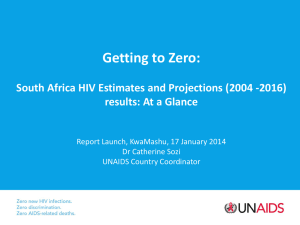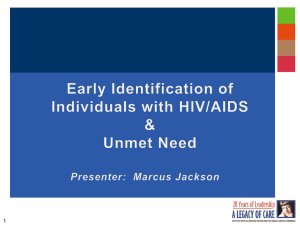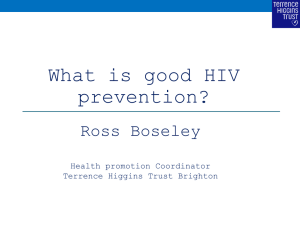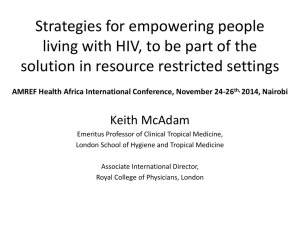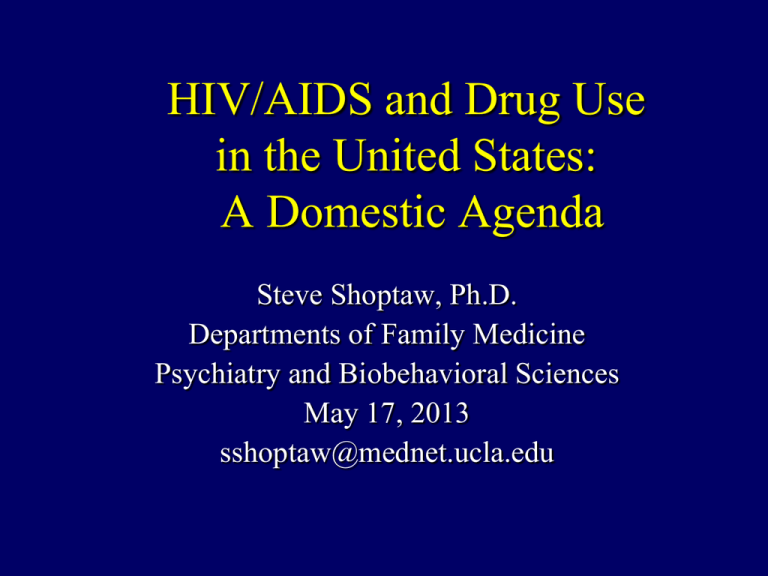
HIV/AIDS and Drug Use
in the United States:
A Domestic Agenda
Steve Shoptaw, Ph.D.
Departments of Family Medicine
Psychiatry and Biobehavioral Sciences
May 17, 2013
sshoptaw@mednet.ucla.edu
Acknowledgments
• CHIPTS – (1MH P30 058107) – Rotheram,
Reback, Veniegas, Landovitz, Kao, Gorbach,
Leibowitz, Coates, Detels
• NIDA – (1 DA P50 018185; 1 DA R01 029804;
1 DA R01 030577)
• City and County of Los Angeles
• California HIV Research Program
• Medicinova – grant for clinical supplies
• Pfizer – grant for clinical supplies
Overview
• HIV Prevention Goals and Strategies
• Lowering Infectiousness in HIV+ Substance
Users
•
•
•
•
TasP
Opioid substitution
Harm reduction
Access to ART
• Reducing Susceptibility in HIV – Substance
Users
•
•
•
•
PrEP
PEP
Immune mechanisms and drug use
Behavioral Programs
• Drug Abuse Treatment as HIV Prevention
• Final Thoughts
Overview
HIV EPIDEMIOLOGY
FIND NEW POSITIVES
LA County HIV Prevention Planning Report, 2013
HIV/AIDS Strategy: Shift to Medical Model
LA County HIV Prevention Planning Report, 2013
Crude Map of Viral Load in LA County
Risk Groups by Year, Los Angeles County
LA County HIV Prevention Planning Report, 2013
Disproportionate Racial Burden
LA County HIV Prevention Planning Report, 2013
Overview
HIV PREVENTION
Aspirational Goals
GETTING TO ZERO
• Sexual transmission
reduced by 50%
– Youth, MSM, Sex Workers
• No vertical transmission
• Transmissions via drug
use eliminated
• Universal access to ART
• HIV-TB deaths < by 50%
• Social justice; no stigma
National HIV/AIDS Strategy
The United States will become a
place where new HIV infections
are rare and when they do occur,
every person, regardless of age,
gender, race/ethnicity, sexual
orientation, gender identity or
socio-economic circumstance,
will have unfettered access to
high quality, life-extending care,
free from stigma and
discrimination.
Compelling tools for
combination prevention
• Prevention in
Positives
– Testing and linkage
to care
– Assertive cART for
Prevention
– Positive prevention
behavioral change
– Facilitation of cART
Adherence
• Prevention in
Negatives
– “ABC”
– Male circumcision
– Needle exchange and
substance use therapy
– Structural reform
• School attendance
• Gender empowerment
and education of women
– Topical/oral PrEP
Sten Vermund, June 2011 HPTN Annual Mtg
Clinical trial evidence for preventing
sexual HIV transmission – June 2011
Study
Effect size (CI)
Treatment for prevention
96% (73; 99)
(HPTN 052; Africa, Asia, America’s)
Medical male circumcision
54% (38; 66)
(Orange Farm, Rakai, Kisumu)
Oral PrEP for MSMs
44% (15; 63)
(iPrEx: Americas, Thailand, Africa)
STD treatment
42% (21; 58)
(Mwanza)
Microbicide
39% (6; 60)
(CAPRISA 004 tenofovir gel)
RV-144 Vaccine
31% (1; 51)
(Thailand)
0%
20
40
60
Efficacy
Sten Vermund, June 2011 HPTN Annual Mtg
80
100%
ART as Disease Prevention
HIV TREATMENT AS
PREVENTION
Profound Effects of ART in Preventing Death
• CASCADE Collaboration
• 22 cohorts pooled with
known dates of HIV
seroconversion
• Gains not even:
– MSM decreased deaths
from malignancies and Ois
– IDUs increased deaths
due to unintentional
deaths
Smit et al., 2006, AIDS, 20:
741-749
Benefits of Starting Early:
Individual and Couples
HIV TREATMENT BENEFITS
HPTN 052
Cohen et al., 2011, NEJM, 365: 493-505
ART Confers Protection: Details for HPTN 052
• 1763 serodiscordant couples enrolled;
– All sexually active in past year; ~6% had unprotected sex
• 886 to early therapy; 877 to delayed therapy
– 448 and 424 CD4 cells/mm3 at baseline
– 603 and 399 CD4 cells/mm3 at 12-months
• 39 HIV-transmission events
– 96% reduction in linked transmissions for early treatment! Hazard
rate=0.04, CI=0.01-0.28
– 4 in early therapy group (incidence=0.3/100ppy CI 0.1-0.6
• Only 1 linked transmission in this group; problem with adherence
– 35 in delayed group (incidence=2.2/100ppy CI 1.6-3.1)
• 27 linked transmissions in this group
• Hazard rate for clinical events for early treatment:
– 0.59 CI 0.40-0.89; primarily in prevention of extrapulmonary TB
Lowering Infectiousness
HIV TREATMENT AS HIV
PREVENTION
Strategy for HIV Combination
Prevention in HIV+ Substance Users
• Reduce Infectiousness: Reduce viral loads in
HIV-positive groups of substance users
– Reduces “transmission potential” across
population
– Foundation of the seek, test, treat, retain
approach
– Departure from advocacy strategies guiding HIV
prevention
– No data yet to test TasP in HIV+ drug users
Kurth et al., 2011, Current HIV/AIDS Reports,1-11
Reducing HIV Incidence in IDUs
Degenhardt et al., 2010, Lancet, 376:285-301
IDUs and Their Risk Environments
• Ensuring access to
ART, OST and
NSP is important;
• IDUs interact with
individuals outside
IDU networks
• Opportunities for
structural
interventions
Strathdee et al., 2010, Lancet, 376, 268-284
ART in IDUs and NIDUs:
Access Denied
EVER Get ART?
N=1730
ART for 95%+ of Time
N=1275
Age (per year)
1.03 CI 1.02-1.04
1.02 CI 1.01-1.04
Baseline CD4<200 cell
4.43 CI 3.19-6.16
1.15 CI 0.89-1.48
Baseline PVL>5 log10
1.68 CI 1.2-2.35
0.68 CI 0.47-0.81
Black Race
0.57 CI 0.44-0.73
0.65 CI 0.51-0.83
IDU History
0.47 CI 0.33-0.67
0.63 CI 0.44-0.90
NIDU History
0.62 CI 0.47-0.81
0.66 CI 0.52-0.85
McGowan et al., 2011. PLOSOne, 6:e18462
Effects of ART Among IDUs
Nolan et al., 2011. AIDS Care, 23:980-987
Apathy, Addictophobia, Inattention
• Limited access to ARTs for HIV+ IDUs in resourced
and in developing countries
– Begs the question of starting ART early
• Political stances against opioid substitution
therapies and needle and syringe programs
present structural barriers to averting infections
• Inattention to marginalized groups (e.g., street
youth, sex workers; itinerant workers) who engage
IDU
Strathdee et al., 2012, Curr Opin HIV/AIDS
Current Status
• Models suggest, but no data exist to
determine benefits of TasP for IDU or nonIDU substance users
– Proof of concept studies excluded these due to
concerns over medication adherence problems.
• HPTN 074 will address TasP among IDUs in
countries with HIV incidence
– Measuring incidence in networks of IDUs and
sexual partners
• Virtually no other studies planned to guide
policy on TasP among HIV+ substance users
Reducing Susceptability
HIV TREATMENT AS HIV
PREVENTION
Strategy for HIV Combination
Prevention in HIV- Substance Users
• Lower susceptibility: Reduce infection in HIVnegative groups
– Biobehavioral approaches – PrEP, PEP for
substance using MSM; other groups at high risk
– Behavioral programs – condom distribution, EBIs
can address structural determinants of risk related
to substance use; no evidence of infections averted
– Surveillance of emerging epidemics linked to drug
use
Kurth et al., 2011, Current HIV/AIDS Reports,1-11
iPrEX: Pre-Exposure Prophylaxis
• Truvada: Tenofovir + Emtracitabine taken
daily
• Tenofovir 1% gel reduced HIV infection in
heterosexual women by 39% (Abdool Karim
et al. 2010)
• Preclinical work shows efficacy in protecting
against HIV transmission in mice and nonhuman primates
• 2,441 MSM followed to 12-months for
seroconversion
iPrEX Results
Grant RM et al N Engl J Med. 2010 363:2587-99.
iPrEX Findings
• Of 100 seroconversions, 36 in Truvada group, a
reduction of 44% over placebo (p=0.005)
• Efficacy was higher in men who reported UAI
(58%) than those who did not
• Adherent men (90%+) showed 73% efficacy
• Efficacy of all subjects was 47% (p=0.001)
• Questions remain about adverse effects,
feasibility/acceptability/ethics
• No indication about substance users as they
were excluded from trials
PEP in MSM
• In Project EXPLORE, MSM who reported any
non-injection drug use increased odds for PEP
by 50% (aOR: 1.5, 95% CI:1.1, 1.9)
– Smoked cocaine, poppers, crack cocaine,
amphetamines and hallucinogens increased odds
– IDUs significantly higher odds of PEP use (aOR: 2.44,
95%CI: 1.69, 3.51).
– Marijuana or cocaine that was snorted or sniffed or
alcohol drinking did not associate with increased odds
for PEP
– No evidence of risk compensation
Donnell et al., 2010, AIDS Behav 14:1182–1189
PEP in Methamphetamine
Using MSM
• When integrated with CM, PEP use among meth-using
MSM appears to be safe and feasible
• Time to PEP initiation (37 h) and reported adherence rates
(96%) are comparable to non-meth-using PEP findings
• CM increased PEP adherence 2% for each MA-negative
urine sample; CM increased PEP completion by 17%
• Meth-using MSM had high rates of risk behavior: high
prevalent STI rates
• Small sample size (n=53), 1 incident seroconversion –
non-adherent to meds and multiple exposures
Landovitz et al. 2012 AIDS Pt Care STDS, 26:320-328
Where Will All the Drug Come From?
• At the end of 2010, 6.6 million on ART (UNAIDS)
– 42% of those in need (CD4 ≤ 350 cells/mm)
• 9 million eligible and in need of treatment
now; 28 million HIV-infected globally
– Attrition cascade at all points from testing to
ART initiation to chronic care
• New infections: 2.6 million in 20101
• Advancements in TasP, PEP and PrEP
create even more demand for ART
1http://wwwunaidsorg/unaids_resources/aidsat30/aids-at-30pdf
TREATMENT OF SUBSTANCE
USE DISORDERS AS HIV
PREVENTION
Opioid Agonist: Medications that bind and activate
opioid receptors (methadone)
Opioid Antagonist: Medications that bind but do not
activate the opiate receptors (naltrexone)
Opioid Partial Agonist: Medication that binds, but does
not fully activate opioid receptors (buprenorphine)
OPIOID REPLACEMENT
Methadone Promotes ART Use
Uhlmann et al., 2010. Addiction, 105, 917-913
ART Adherence and MMT in 545
Homeless IDUS in Vancouver
Palepu et al., 2011. J Urban Health, 88: 545-555
Mechanism: Opioid Replacement
as HIV Prevention
• Reduced craving for and use of illicit opioids
• Reduced frequency of injecting drug use
• Concomitant reductions in sex for money or
drugs
• Better cognitive function and ability to
understand prevention messages
• Less sharing of paraphernalia
• Regular contact with NTP, which increases
chance for medical and psychosocial
interventions
Gowing et al., 2008
Studies on Seroconversion
35
Percent HIV +
30
25
20
Replacmt (n=138)
No Replacmt (n=88)
15
10
5
0
Metzger et al.,
1993
Incidence for Replacement = 3/100 person years
Baseline
18 Months
Incidence for No Replacement = 10/100 person years
Summary:
Methadone and HIV Seroconversion
• Early cohort studies demonstrated effects
of methadone for reducing HIV-incidence
• Continuous methadone maintenance is
seroprotective; interrupted maintenance is
not (Moss et al., 1994)
• Opioid substitution may slow transmission
of treatment resistant virus (Tetrault et al.,
2013)
The Majority of Substance Users
at Risk for HIV Do Not Inject …
Meth Use and HIV
Transmission in MSM
Meth use correlates with
2-4 fold increases in risk
for HIV transmission in:
– Cohort Studies (Plankey
et al., 2007)
– New Infections (Drumright
et al., 2007; 2009)
– STI settings (Buchacz et
al., 2005; Buchbinder et
al., 2005)
50
45
40
35
28.8
30
25
20
15 11.4
10
5
0
Meth
47.7
32.4
22.5
9.6
Poppers
HIV- (n=333)
EDDs
HIV+ (n=111)
Carey et al., AIDS & Beh, 2008
A Probabilistic Event Determined by:
– Characteristics of the behavior
• Unprotected anal ( receptive; insertive)
• Unprotected vaginal ( receptive; insertive)
• Oral behaviors
– Characteristics of the individual
•
•
•
•
Other STIs
Bruised/bleeding mucosa
Viral load
Concurrency
– Characteristics of the event
• Single; multiple sources of virus
Cohen, 2006
Methamphetamine
HIV Transmission
Attributable Risk for HIV Transmission
from Stimulant Use in MSM
1 Koblin
et al., 2006, AIDS, 20, 731-739
2 Ostrow et al., 2009, Journal of Acquired Immune Deficiency Syndrome, 51(3), 349-355
Behavioral Drug Abuse
Treatment as HIV Risk Reduction
• Behavioral Therapies
– Friends Getting Off (Reback & Shoptaw, 2011)
– Contingency Management (Shoptaw et al., 2005)
• Limits to treatment settings (Menza et al., 2010)
• Heterosexual meth users show parallel reductions in
injection and sex risk behaivors (Corsi et al., 2012)
• Medication Therapies
– Mirtazapine (30 mg/d) for meth-dependent MSM
(Colfax et al., 2011) showed reductions in meth use
and concomitant HIV sexual transmission behaviors
Summary
• Opioid substitution therapy increases ART
access and ART adherence
– Also reduces HIV-related transmission behaviors
– May reduce resistant transmission
• Indications that stimulants negatively effect
immune function
– ART access and adherence has profound positive
effects in HIV+ stimulant users
• No addiction medications with same signal
size as opiate and nicotine medications
Standard Approaches
HIV PREVENTION IN
SUBSTANCE USE GROUPS
Behavioral Prevention for HIV+
Substance Users
• After 30+ years, behavioral prevention
reliably reduces risk behaviors, but no
demonstration of infections averted
– Need for inclusion of HIV biomarkers in designs
• CDC Compendium and SAMHSA NREPP
programs catalog interventions with efficacy
in reducing risk behaviors
– Project EDGE (Mausbach et al., 2007) safer sex
program for MSM HIV+ meth users.
Behavioral Prevention for HIVNegative Substance Users
• Woman focused HIV risk reduction program
for African American crack smokers
(Wechsberg et al., 2004)
• Fast Lane, HIV-risk reduction program for
HIV-negative heterosexual meth users
(Mausbach et al., 2007)
FINAL THOUGHTS
Final Thoughts
• Domestic epidemic driven by MSM and their
male (and female) sexual partners
• Racial factor shows disproportionate
involvement of Black MSM
• Structural factors of poverty, substance use
• Disconnect between “proof of concept”
research on HIV treatment and prevention
and the groups who might best benefit
Thank You



